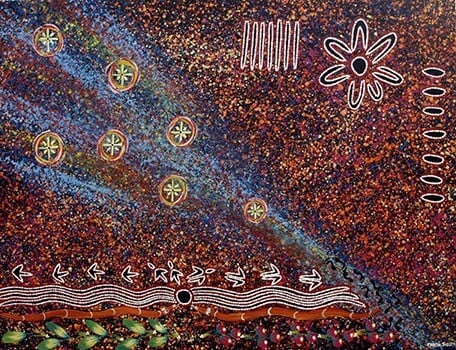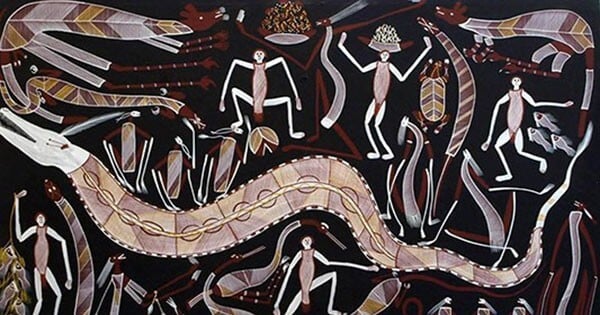The Timeless Tapestry: Unveiling the Profound Significance of Dreamtime in Aboriginal Culture
The Timeless Tapestry: Unveiling the Profound Significance of Dreamtime in Aboriginal Culture

The Australian landscape, vast and ancient, whispers stories of a time before time, a realm where the physical and spiritual intertwine. This is the Dreamtime, a central concept in Aboriginal culture, a potent force that shapes their worldview, beliefs, and connection to the land. It’s not just a myth or a legend; it’s the very fabric of their existence, a living, breathing entity that binds them to their ancestral past and guides their present.
A Universe Woven from Dreams:
Related Articles: The Timeless Tapestry: Unveiling the Profound Significance of Dreamtime in Aboriginal Culture
- The Enduring Voices Of Australia: A Journey Into Tribal Languages
- Aboriginal Facial FeaturesTitle
- The Enduring Spirit: A Journey Into The World Of Indigenous Australians
- A Taste Of Paradise: Exploring Australia’s Most Popular Fruits
- The Timeless Tapestry Of Aboriginal Totems: A Journey Into Cultural Identity And Connection
The Dreamtime, often referred to as "The Dreaming" or "The Law," transcends the limitations of linear time. It’s a realm where the ancestors, powerful beings who shaped the land and its inhabitants, walked the earth. Their actions, their journeys, their struggles, and triumphs are imprinted on the land, etched in the shape of mountains, the flow of rivers, the distribution of plants and animals. The Dreamtime is a timeless narrative, a repository of knowledge passed down through generations, shaping the lives of Aboriginal people across the continent.
Beyond the Physical:
The Dreamtime is not merely a historical account; it’s a dynamic force that continues to influence the present. It’s a spiritual guide, a source of moral and ethical codes, a framework for understanding the natural world and their place within it. Through rituals, ceremonies, and storytelling, Aboriginal people connect with the Dreamtime, seeking guidance and reaffirming their connection to their ancestors and the land.
The Ancestral Legacy:
The Dreamtime stories are not just tales; they are the blueprint for life. They reveal the origins of the land, its animals, plants, and the people themselves. They explain the customs, laws, and social structures that govern their communities. Each tribe, each clan, has its own unique Dreamtime stories, passed down through generations, ensuring the preservation of their cultural heritage.
The Land as a Living Canvas:
For Aboriginal people, the land is not just a resource; it is a living entity, a sacred space imbued with the power of the Dreamtime. Every rock, every tree, every waterhole is infused with ancestral energy, holding stories of creation and transformation. It’s a landscape that whispers secrets, a living museum of the past, present, and future.
The Power of Ceremony:

Ceremonies are the heartbeat of Aboriginal culture, providing a tangible connection to the Dreamtime. Through dance, song, and ritual, Aboriginal people re-enact the stories of their ancestors, honoring their legacy and reaffirming their connection to the land. These ceremonies are not just performances; they are acts of spiritual renewal, ensuring the continuity of their cultural heritage.
The Importance of Storytelling:
Storytelling is a vital aspect of Dreamtime, serving as a powerful tool for transmitting knowledge, values, and beliefs. Through oral traditions, the stories are passed down through generations, ensuring the preservation of cultural identity. These stories are more than just narratives; they are living, breathing entities that connect the past, present, and future.
The Dreamtime and the Modern World:
Despite the challenges of colonization and modernization, the Dreamtime remains a vital force in Aboriginal culture. It provides a sense of identity, a connection to the past, and a framework for navigating the complexities of the modern world. It’s a source of strength, resilience, and hope, reminding them of their enduring spirit and the enduring power of their ancestral heritage.
The Dreamtime: A Source of Inspiration:
The Dreamtime is not just a cultural phenomenon; it’s a powerful source of inspiration for artists, writers, and thinkers across the globe. It offers a unique perspective on the relationship between humanity and the natural world, a perspective that resonates with contemporary concerns about environmental sustainability and cultural preservation.
The Dreamtime: A Call to Action:
Understanding the Dreamtime is not just an academic exercise; it’s a call to action. It’s a call to respect the land, to honor the indigenous cultures of Australia, and to recognize the profound wisdom that lies within their traditions. It’s a reminder that the past is not just a relic; it’s a living, breathing force that shapes the present and guides the future.
Frequently Asked Questions about Dreamtime:

1. What is the Dreamtime?
The Dreamtime is a central concept in Aboriginal culture, representing a timeless realm where the ancestors created the land and its inhabitants. It’s a spiritual and cultural foundation that shapes their worldview, beliefs, and connection to the land.
2. How does the Dreamtime influence Aboriginal life?
The Dreamtime provides a framework for understanding the natural world, their social structures, and their moral and ethical codes. It guides their ceremonies, rituals, and storytelling, ensuring the preservation of their cultural heritage.
3. What are some examples of Dreamtime stories?
Dreamtime stories vary across tribes and clans, but they often depict the creation of specific landmarks, animals, plants, and even social structures. For example, the story of the Rainbow Serpent explains the formation of rivers and waterholes, while the story of the Seven Sisters explains the constellation of the Pleiades.
4. How is the Dreamtime celebrated?
Aboriginal people celebrate the Dreamtime through ceremonies, rituals, and storytelling. These ceremonies often involve dance, song, and elaborate costumes, re-enacting the stories of their ancestors and reaffirming their connection to the land.
5. Why is it important to learn about the Dreamtime?
Understanding the Dreamtime is crucial for appreciating the richness and diversity of Aboriginal culture. It provides a unique perspective on the relationship between humanity and the natural world, fostering respect for indigenous knowledge systems and cultural heritage.
6. How can I learn more about the Dreamtime?
There are many resources available to learn more about the Dreamtime, including books, documentaries, and websites. You can also visit Aboriginal art galleries, museums, and cultural centers to experience firsthand the artistic and cultural expressions of the Dreamtime.
7. How can I support the preservation of Aboriginal culture?
You can support the preservation of Aboriginal culture by learning about their history, beliefs, and traditions. You can also support Aboriginal artists and businesses, attend cultural events, and advocate for the recognition and protection of their rights and land.
The Dreamtime is not just a story; it’s a living, breathing force that shapes the lives of Aboriginal people and their connection to the land. It’s a testament to the power of cultural heritage, a reminder of the importance of storytelling, and a call for respect and understanding. By embracing the wisdom of the Dreamtime, we can learn to appreciate the interconnectedness of all things and strive for a more just and sustainable future.

Closure
Thus, we hope this article has provided valuable insights into The Timeless Tapestry: Unveiling the Profound Significance of Dreamtime in Aboriginal Culture. We appreciate your attention to our article. See you in our next article!



